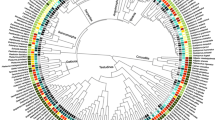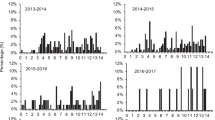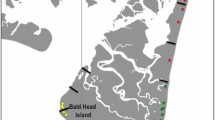Abstract
Populations that experience different local climates, such as those along a latitudinal gradient, must match life history traits to local environmental conditions. In species with temperature-dependent sex determination, such as many reptiles, population sex ratio is strongly influenced by local climate, yet local climate differs substantially among populations in geographically-widespread species. We studied the painted turtle at three sites across the species’ geographic range to gain a mechanistic understanding of how sex ratios are produced under different local climates. We combined data on maternal nest-site choice, nest incubation temperature, and the resultant offspring sex ratio of populations across a climatic gradient, to demonstrate how geographic variation in behavior and physiology translates into sex ratios among populations of a widely-distributed species. We found that populations across the species’ geographic range match incubation conditions with local climatic conditions through population-specific adjustment of maternal nest-site choice. Incubation temperatures during the thermosensitive period were cooler and clutches were more male-biased in the south, with populations farther north having warmer incubation temperatures and more female-biased sex ratios, yet adult sex ratios were not strongly biased in any population. Most components of maternal nest-site choice varied latitudinally among populations, suggesting that the species may have a considerable repertoire for responding to climate change through adjustment of nest-site choice.



Similar content being viewed by others
References
Atkins KE, Travis JMJ (2010) Local adaptation and the evolution of species’ ranges under climate change. J Theor Biol 266:449–457
Bull JJ, Vogt RC, McCoy CJ (1982) Sex determining temperatures in turtles: a geographic comparison. Evolution 36:326–332
Bulmer MG, Bull JJ (1982) Models of polygenic sex determination and sex ratio control. Evolution 36:13–26
Burnham KP, Anderson DR (2002) Model selection and multimodel inference: a practical information-theoretic approach. Springer, New York
Chu CT, Booth DT, Limpus CJ (2008) Estimating the sex ratio of loggerhead turtle hatchlings at Mon Repos rookery (Australia) from nest temperatures. Aust J Zool 56:57–64
De Frenne P, Graae BJ, Rodríguez-Sánchez F et al (2013) Latitudinal gradients as natural laboratories to infer species’ responses to temperature. J Ecol 101:784–795
Doody JS (2009) Superficial lizards in cold climates: nest site choice along an elevational gradient. Austral Ecol 34:773–779
Doody JS, Guarino E, Georges A, Corey B, Murray G, Ewert M (2006) Nest site choice compensates for climate effects on sex ratios in a lizard with environmental sex determination. Evol Ecol 20:307–330
Ernst CH (1971) Population dynamics and activity cycles of Chrysemys picta in southeastern Pennsylvania. J Herpetol 5:151–160
Ernst CH, Lovich JE (2009) Turtles of the United States and Canada. Johns Hopkins University Press, Baltimore
Ewert MA, Jackson DR, Nelson CE (1994) Patterns of temperature-dependent sex determination in turtles. J Exp Zool 270:3–15
Ewert MA, Lang JW, Nelson CE (2005) Geographic variation in the pattern of temperature-dependent sex determination in the American snapping turtle (Chelydra serpentina). J Zool 265:81–95
Frazer GW, Canham CD, Lertzman KP (1999) Gap Light Analyzer (GLA), Version 2.0: Imaging software to extract canopy structure and gap light transmission indices from true-colour fisheye photographs. Simon Fraser University, Burnaby
Freedberg S, Bowne ER (2006) Monitoring juveniles across years reveals non-Fisherian sex ratios in a reptile with environmental sex determination. Evol Ecol Res 8:1499–1510
Gamble T (2006) The relative efficiency of basking and hoop traps for painted turtles (Chrysemys picta). Herpetol Rev 37:308–312
Girondot M (1999) Statistical description of temperature-dependent sex determination using maximum likelihood. Evol Ecol Res 1:479–486
Janzen FJ (1994a) Climate change and temperature-dependent sex determination in reptiles. Proc Natl Acad Sci 91:7487–7490
Janzen FJ (1994b) Vegetational cover predicts the sex ratio of hatchling turtles in natural nests. Ecology 75:1593–1599
Janzen FJ, Morjan CL (2001) Repeatability of microenvironment-specific nesting behaviour in a turtle with environmental sex determination. Anim Behav 62:73–82
Lovich JE, Gibbons JW (1990) Age at maturity influences adult sex ratio in the turtle Malaclemys terrapin. Oikos 59:126–134
McGaugh SE, Janzen FJ (2011) Effective heritability of targets of sex-ratio selection under environmental sex determination. J Evol Biol 24:784–794
Mitchell NJ, Janzen FJ (2010) Temperature-dependent sex determination and contemporary climate change. Sex Dev 4:129–140
Mitchell NJ, Kearney MR, Nelson NJ, Porter WP (2008) Predicting the fate of a living fossil: how will global warming affect sex determination and hatching phenology in the tuatara? Proc R Soc Lond B 275:2185–2193
Morjan CL (2002) Temperature-dependent sex determination and the evolutionary potential for sex ratio in the painted turtle, Chrysemys picta. PhD Thesis, Iowa State University
Morjan CL (2003) Variation in nesting patterns affecting nest temperatures in two populations of painted turtles (Chrysemys picta) with temperature-dependent sex determination. Behav Ecol Sociobiol 53:254–261
Neuwald J, Valenzuela N (2011) The lesser known challenge of climate change: thermal variance and sex-reversal in vertebrates with temperature-dependent sex determination. PLoS One 6:1–9
Paukstis GL, Shuman RD, Janzen FJ (1989) Supercooling and freeze tolerance in hatchling painted turtles (Chrysemys picta). Can J Zool 67:1082–1084
Ratterman RJ, Ackerman RA (1989) The water exchange and hydric microclimate of painted turtle (Chrysemys picta) eggs incubating in field nests. Physiol Zool 62:1059–1079
Refsnider JM, Warner DA, Janzen FJ (2013) Does shade cover availability limit nest-site choice in two populations of turtles with temperature-dependent sex determination? J Therm Biol 38:152–158
Schwanz LE, Janzen FJ, Proulx SR (2010a) Sex allocation based on relative and absolute condition. Evolution 64:1331–1345
Schwanz LA, Spencer R-J, Bowden RM, Janzen FJ (2010b) Climate and predation dominate juvenile and adult recruitment in a turtle with temperature-dependent sex determination. Ecology 91:3016–3026
Schwarzkopf L, Brooks RJ (1985) Sex determination in northern painted turtles: effects of incubation at constant and fluctuating temperatures. Can J Zool 63:2543–2547
Schwarzkopf L, Brooks RJ (1987) Nest-site selection and offspring sex ratio in painted turtles, Chrysemys picta. Copeia 1:55–61
Scribner KT, Congdon JD, Chesser RK, Smith MH (1993) Annual differences in female reproductive success affect spatial and cohort-specific genotypic heterogeneity in painted turtles. Evolution 47:1360–1373
Strickland JT, Janzen FJ (2010) Impacts of anthropogenic structures on predation of painted turtle (Chrysemys picta) nests. Chelonian Conserv Biol 9:131–135
Telemeco RS, Abbott KC, Janzen FJ (2013) Modeling the effects of climate change-induced shifts in reproductive phenology on temperature-dependent traits. Am Nat 181:637–648
Tucker JK, Dolan CR, Lamer JT, Dustman EA (2008) Climatic warming, sex ratios, and red-eared sliders (Trachemys scripta elegans) in Illinois. Chelonian Conserv Biol 7:60–69
Wibbels T, Bull JJ, Crews D (1994) Temperature-dependent sex determination: a mechanistic approach. J Exp Zool 270:71–78
Wilson K, Hardy ICW (2002) Statistical analysis of sex ratios: an introduction. In: Hardy ICW (ed) Sex ratios: concepts and research methods. Cambridge University Press, Cambridge, pp 47–92
Acknowledgments
This study was funded by the William Clark Graduate Student Award in Ecology and Evolutionary Biology (to J.M.R.); NSF Graduate Student Fellowship, Sigma Xi Grants-in-Aid of Research, American Society of Icthyologists and Herpetologists Gaige Award, and Leopold Brown Trust Fellowship from Iowa State University (to C.M.-Z.); and NSF DEB-9629529 and DEB-064932 (to F.J.J.). We thank A. Inslee and the staff at Bosque del Apache NWR for hospitality at the New Mexico site; the U.S. Army Corps of Engineers and members of the 2006–2011 Turtle Camp Research Crews for dedicated data collection at the Illinois site; and W. Brininger, N. Powers, and H. Streby for access to and accommodation at the Minnesota site. This research was conducted in accordance with Institutional Animal Care and Use Committee protocols 1-8-3785-1-J, 12-03-5570-J, and 6-08-6583-J (Iowa State University); Scientific Collecting Permits 3040 and 3430 (New Mexico Department of Game and Fish); Scientific Collecting Permits NH98.0099 and NH10.0073 (Illinois Department of Natural Resources); Scientific Research Permit 17839 (Minnesota Department of Natural Resources); and Special Use Permits 98006, 32576-OA022, and 32560-12-025 (U.S. Fish and Wildlife Service). The Janzen Lab at Iowa State University and three anonymous reviewers provided helpful comments on the manuscript.
Author information
Authors and Affiliations
Corresponding author
Electronic supplementary material
Below is the link to the electronic supplementary material.
Rights and permissions
About this article
Cite this article
Refsnider, J.M., Milne-Zelman, C., Warner, D.A. et al. Population sex ratios under differing local climates in a reptile with environmental sex determination. Evol Ecol 28, 977–989 (2014). https://doi.org/10.1007/s10682-014-9710-2
Received:
Accepted:
Published:
Issue Date:
DOI: https://doi.org/10.1007/s10682-014-9710-2




